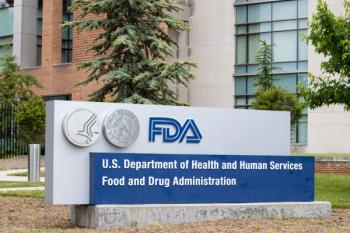
Sugammadex Safe, Effective Post Surgery in Myasthenia Gravis
Key Takeaways
- Sugammadex effectively reverses neuromuscular blockade in myasthenia gravis patients, ensuring rapid recovery and minimal complications.
- The review of 24 studies with 1679 patients showed no significant increase in myasthenic crisis risk.
Sugammadex (Bridion; Merck) is a small-molecule oligosaccharide, also known as a modified gamma cyclodextin, that was approved by the FDA in 2015 to reverse the anesthesia-induced neuromuscular blockade from rocuronium bromide or vecuronium bromide.
Sugammadex (Bridion; Merck) administered to reverse the neuromuscular blockade patients with
With most present data on sugammadex use in the myasthenia gravis setting garnered from case studies or series, limiting its generalizability to a wider population, the present authors were seeking to fill the knowledge gap with periodic reviews of available safety and efficacy findings. They included 24 studies, encompassing 1679 patients, with a low risk of bias in their analysis after searching PubMed, Embase, and Web of Science using the terms sugammadex, gamma cyclodextrin, and myasthenia gravis, as well as looking for studies that evaluated safety and efficacy; all of the studies were published between August 2010 and March 27, 2024, and had to have included patients with myasthenia gravis placed under general anesthesia and investigated neuromuscular blockade reversal with sugammadex or sugammadex vs neostigmine. The most common surgery was thymectomy.
Advantages of Sugammadex
The unique disease pathophysiology of myasthenia gravis predisposes patients with the autoimmune disorder to high risks of death, severe complications, and myasthenic crisis following surgery and anesthesia that involve neuromuscular blockade.2,3 Anesthesia management in these patients can be especially challenging because they frequently lack adequate levels of acetylcholine and demonstrate resistance to depolarizing neuromuscular blocking agents, the study authors explain.1 Sugammadex was approved by the FDA in 2015 as a reversal agent for the neuromuscular-blocking effects of rocuronium bromide or vecuronium bromide in adult patients with myasthenia gravis4,5; data show it can selectively reverse neuromuscular blockade while not interacting with acetylcholine receptors or acetylcholinesterase inhibitors.1
For the studies included, data were collected on study type, mean patient age, gender, and type of surgical encounter. Patient outcome information comprised time between sugammadex administration and 90% recovery, extubation, and spontaneous breathing; in-hospital deaths; use of plasma exchange and immunoglobulins after surgery; and occurrence of myasthenic crises.
Recovery times following depolarization of neuromuscular blockade ranged from 79.7 seconds for moderate neuromuscular blockade to 10 minutes for a pediatric patient, according to 90% recovery via Train-of-Four criteria—a method of nerve stimulation to monitor recovery after neuromuscular blockade.6 The reviewers also saw a short average time to extubation of 2 minutes following a caesarean section to 4.6 minutes (276 seconds) among 117 patients, “emphasizing [sugammadex’s] swift action in facilitating spontaneous breathing and extubation.” An outlier here was 48 hours seen among 1 patient who had undiagnosed myasthenia gravis.
The data also demonstrate that sugammadex presented no significant increased risk of myasthenic crisis, which is severe exacerbation of myasthenia gravis symptoms. Among the overall 1679 patients, 1 patient required plasma exchange and had to be reintubated,7 while 6.4% of patients from a retrospective study of 873 patients needed immunoglobulin treatment (n = 17) or plasma exchange (n = 39).8 There were no patient deaths and a noticeable absence of major adverse effects.1
“The consistent and rapid recovery times, coupled with the low incidence of severe complications,” the authors concluded, “make sugammadex a reliable choice in clinical settings requiring prompt and safe reversal of neuromuscular blockades.”
Concluding Thoughts
The study authors explain that strength in their findings stem from knowing that patients with myasthenia gravis present a unique challenge for anesthetic management, because there is significant variation in how they respond to neuromuscular blockade. Therefore, anesthetists avoid or limit the use of these agents in this patient population. However, often for surgery, neuromuscular blockade is unavoidable and the most common reversal agents are anticholinesterase agents, which constitute a safety risk in myasthenia gravis and can be ineffective when used on patients already being chronically treated with anticholinergic therapy.
They also emphasize the need for further research among larger and more diverse populations, due to apparent variability in the impact sugammadex has on patients, and investigating the potential link between plasma exchange/immunoglobulin therapy and myasthenic crisis.
References
1. Kaye AD, Villafarra EA, Everett ES, et al. Safety and efficacy of sugammadex in management of patients with myasthenia gravis undergoing general anesthesia: a systematic review. Heliyon. 2025;11(2):e41757. doi:10.1016/j.heliyon.2025.e41757
2. Rudzka-Nowak A, Piechota M. Anaesthetic management of a patient with myasthenia gravis for abdominal surgery using sugammadex. Arch Med Sci. 2011;7(2):361-364. doi:10.5114/aoms.2011.22094
3. Daum P, Smelt J, Ibrahim IR. Perioperative management of myasthenia gravis. BJA Educ. 2021;21(11):414-419. doi:10.1016/j.bjae.2021.07.001
4. Merck’s Bridion (sugammadex) seceives FDA approval for the reversal of neuromuscular blockade induced by rocuronium and vecuronium in adults undergoing surgery. News release. December 17, 2015. Accessed February 17, 2025.
5. Sugammadex. DrugBank. Accessed February 17, 2025.
6. Tschida SJ, Hoey LL, Mather D, Vance-Bryan K. Train-of-four: to use or not to use. Pharmacotherapy. 1995;15(4):546-550.
7. Lai HC, Huang TW, Tseng WC, Wu TS, Wu ZF. Sugammadex and postoperative myasthenic crisis. J Clin Anesth. 2019;57:63. doi:10.1016/j.jclinane.2019.02.026
8. Tsukada S, Shimizu S, Fushimi K. Rocuronium reversed with sugammadex for thymectomy in myasthenia gravis: a retrospective analysis of complications from Japan. Eur J Anaesthesiol. 2021;38(8):850-855. doi:10.1097/EJA.0000000000001500
Newsletter
Stay ahead of policy, cost, and value—subscribe to AJMC for expert insights at the intersection of clinical care and health economics.








































